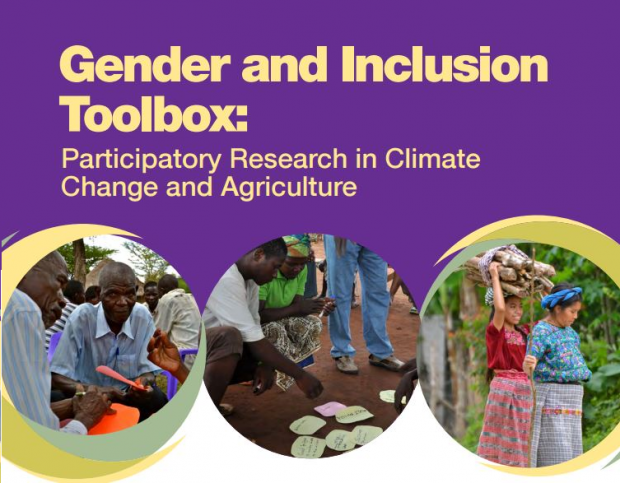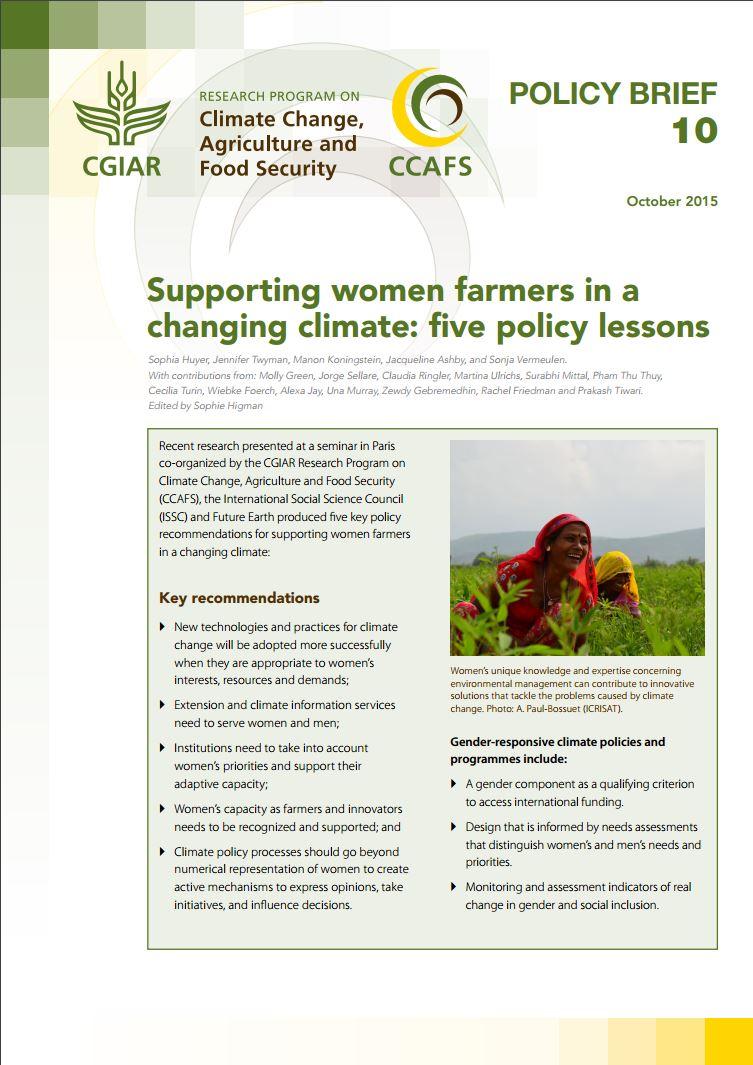An existing gender gap in agriculture affects women and men differently across a wide range of assets and resources as well as experiences and responsibilities. Discriminatory social norms and practices, together with inequitable power dynamics at different levels (e.g. household, community, nation, global) can lead to women’s and men’s differential access to agricultural resources, climate services and information. It can also translate into unequal labour contributions and benefit-sharing. As such, women and men are often affected differently by climate change. As a result, climate change has the potential to worsen poverty and to reinforce gender and other types of social inequalities.
Supporting women farmers in a changing climate: five policy lessons
Women and men can also be powerful agents of innovation in response to climate change and may have different adaptive knowledge and capacities. Engaging women and men in participatory, gender-responsive technology design and management can encourage changes in gender relations, and improve community outcomes and strengthen community climate resilience. However, facilitating such transformation requires an enabling social, political, economic and institutional context.
Young women and men make up a large share of the world’s poor. Youth engaged in agriculture can be more susceptible to poverty and thus the impacts of climate change, in part because of their limited access to assets and participation in decision-making processes as well as limited access to climate information and financial services, markets, and policy dialogue. Long-term adaptation and mitigation strategies must therefore engage young women and men.
Read more:
- Policy brief: Supporting women farmers in a changing climate: five policy lessons
- CSA Practice brief: A gender-responsive approach to climate-smart agriculture
- Tool: Gender and Inclusion Toolbox
Photo: N. Palmer (CIAT)
What we do
CCAFS seeks positive development outcomes for men, women, and youth to ensure households and communities are more resilient under climate change. We do this by conducting strategic gender responsive research; by integrating gender and social analysis across the program’s thematic areas and regions; by providing support and knowledge to staff, partners, and other stakeholders on how to address gender and social inclusion in their work, and; by conducting impact assessments to assess the research benefits to women and men.

CCAFS undertakes strategic and integrated gender and social inclusion research that informs, catalyses and targets solutions for women, men, and youth in communities to increase their control over productive assets and resources (e.g. climate information, novel climate finance), and increase participation in decision-making (e.g. in local and national climate adaptation strategies). We do this through following three main approaches:
- Vulnerabilities: This approach assesses the impacts of climate change on livelihood strategies and food systems, and works with women, men and youth to enhance their knowledge and capacities.
- Gender transformation: Gender analysis and research seeks to promote gender transformation of gender roles and relations, and promotes women’s greater equality, responsibilities, status, and access to and control over resources, services and decision-making.
- Strengthening institutions: Finally, CCAFS works by strengthening institutions to increase the agency of women, men and youth.
CCAFS Gender and Social Inclusion Strategy (April 2016)
Gender and Social Inclusion Strategy
CCAFS has a new Gender and Social Inclusion (GSI) Strategy which is an update of the 2012 CCAFS Gender Strategy. The strategy addresses gender and social inclusion for different social groups while bearing in mind that women are central to agriculture in many areas of the world. The new GSI Strategy is a result of planning for Phase II of the CCAFS program and builds on the program’s research and experience since 2010.
Goal of the Strategy
The main goal of the GSI strategy is to promote gender equality in CCAFS’ work towards climate smart agriculture, food systems and landscapes. The GSI strategy aligns with the CGIAR strategy’s priorities to create opportunities for women, young people and marginalized groups and to promote equitable access to resources, information and power in the agri-food system for men and women in order to close the gender gap by 2030.
Read more: CCAFS Gender and Social Inclusion Strategy
Key gender and social inclusion research activities
Research activities include:Flagship Program Leaders and Regional Program Leaders are responsible for integrating gender and social inclusion into CCAFS research in collaboration with the Gender and Social Inclusion Research Leader and Science Officer, and a network of gender and climate change researchers.
- Analysis of Gender Household Survey data in Climate-Smart Villages (CSVs), to provide a baseline for the gender and youth development outcomes.
- Analysis of household decision-making methodologies in adaptation and mitigation.
- Testing of enabling mechanisms, tools and frameworks, and scaling up strategies and measurement frameworks for gender equality in CSA.
- Investigation of climate finance instruments to support women’s adaptation and mitigation-based enterprises
- Investigation of gender and youth engagement in global and national climate policy research
- Value chain research to assess women’s and youth engagement in supply chains, and their access to technical information, and barriers to participation.
CCAFS also undertakes GSI integrated research across its projects to assess and synthesize gender research as well as support new research. This is supported by:
- CSA gender focal points across Centres;
- Gender analysis in design, implementation and ex post impact assessment; gender indicators, outputs and outcomes;
- Integration of GSI into conceptual frameworks, research guides and workplans.
- Gender impact assessments in a more systematic manner for all programs, as part of reporting on gender impacts, indicators and outcomes.
Who are we? Browse through the core staff members of the CCAFS Gender and Social Inclusion theme

Photo: N. Palmer (CIAT)
Some of the key findings to date
- Agriculture is the largest sector for women’s employment in three regions – Oceania, South Asia and sub-Saharan Africa – employing 60% of women (United Nations 2015b).
- In least developed countries 79% of economically active women report agriculture as their primary economic activity, while rural women play an increasing role in smallholder agriculture as a result of out-migration of males (FAO 2011).
- Women make up 43% of the global agricultural labour force, although there is evidence that they are in fact involved in many facets of agricultural production that are under-reported (FAO 2011; Doss 2015).
- Globally, women’s land ownership lags behind men’s: women make up roughly 15% of agricultural land holders in sub-Saharan Africa, 20% in Latin America, and 10% in South and Southeast Asia (FAO 2011).
- Women have lower levels of access to and control over key agricultural resources: finance and credit; extension; and agricultural inputs (World Bank 2012; FAO 2011).
- The gender gap in agriculture exists across a range of assets and resources. Women have less access to financial capital and key resources such as water, livestock, grazing and fisheries. They have less capacity to capture beneficial environmental services; less participation in decision-making; and lower levels of access to labour, technology, training, information and agricultural advisory services. The TerrAfrica partnership found that insecure land tenure, lack of capital and limited farm inputs – all common problems for women farmers – were all major barriers to the adoption of conservation agriculture in sub-Saharan Africa (Ashby et al. 2012; Beuchelt et al 2013; Goh 2012; Twyman et al. 2014; Jost et al 2015).
- Women appear to be less adaptive because of financial or resource constraints, because of male domination in receiving information and extension services and because available adaptation strategies tend to create higher labour loads for women (Jost et al 2015).
- CCAFS research in the lead up to COP21 found that women and men farmers in developing countries have different vulnerabilities and capacities to deal with the impact of climate change on agriculture (Huyer et al. 2015).
- Gender receives attention in about 40% of the Intended Nationally Determined Contributions (INDCs) submitted ahead of COP21, none from Annex 1 countries (Huyer 2016).
- The use of the term ”gender-responsive” in the Paris Agreement is a big step forward, however the Agreement fails to move beyond the attitude of women as victims of climate change in need of capacity building (Huyer 2016).
- CCAFS research in Costa Rica on Nationally Appropriate Mitigation Actions (NAMA) Women’s capacities may be enhanced through their inclusion in farmer field schools and the use of household methodologies that engage men and women in seeking better joint outcomes for the household, while ensuring benefits to women (Farnworth, 2015).
- Research undertaken in four sites across East and West Africa found that women are less likely than men to be aware of CSA practices, but just as likely as men, if not more so, to adopt such practices if they are aware. Investing in CSA programs that effectively reach women with climate and agriculture information is likely to result in uptake of new agricultural practices for adaptation. (Twyman et al 2014).
- Results from CCAFS’ research conducted in Kaffrine, Senegal point to the need for national adaption plans that target gender as an important determinant in the experience of climate related events. (Tall et al 2014).


